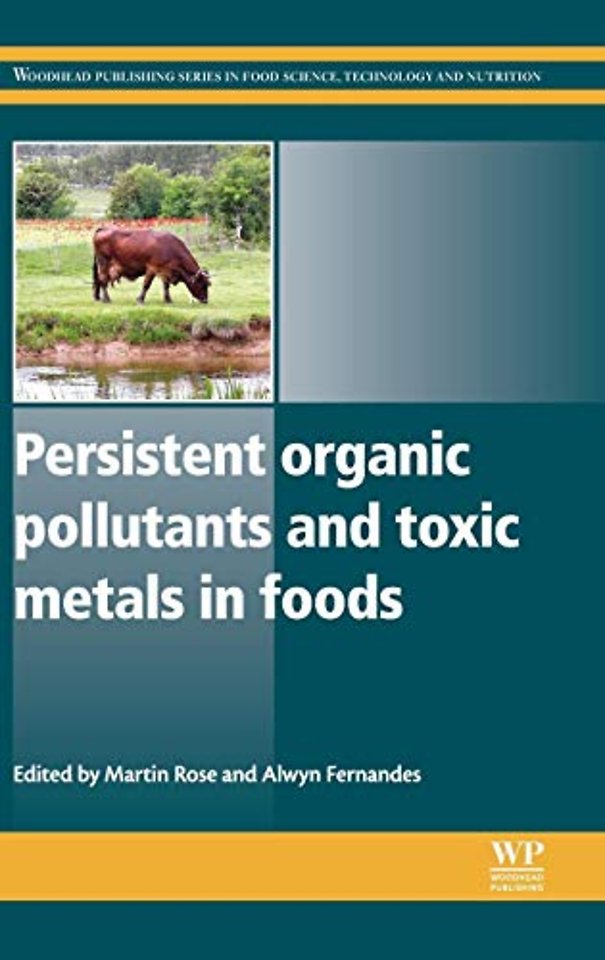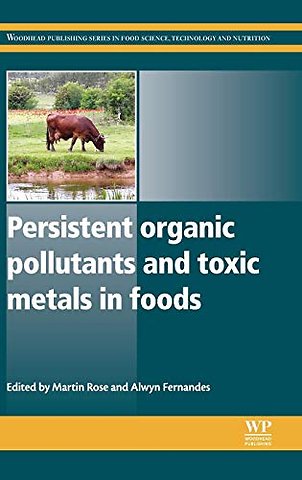<p>Contributor contact details</p> <p>Woodhead Publishing Series in Food Science, Technology and Nutrition</p> <p>Foreword</p> <p>Preface</p> <p>Part I: Regulatory control and environmental pathways</p> <p>Chapter 1: Persistent organic pollutants in foods: science, policy and regulation</p> <p>Abstract:</p> <p>1.1 Introduction</p> <p>1.2 Dietary exposure and total diet studies (TDSs)</p> <p>1.3 Risk assessment, policy making and regulatory limits</p> <p>1.4 Enforcement and implications for food businesses</p> <p>1.5 Analytical methods and their influence on policy</p> <p>1.6 Future trends and conclusions</p> <p>1.7 References</p> <p>Chapter 2: Regulatory control and monitoring of heavy metals and trace elements in foods</p> <p>Abstract:</p> <p>2.1 Introduction</p> <p>2.2 Risk assessment and policy making</p> <p>2.3 Monitoring of foodstuffs</p> <p>2.4 Impact of legislation on industry and enforcement</p> <p>2.5 Suitability of analytical methods</p> <p>2.6 Future trends</p> <p>2.7 Sources of further information</p> <p>2.8 References</p> <p>Chapter 3: Screening and confirmatory methods for the detection of dioxins and polychlorinated biphenyls (PCBs) in foods</p> <p>Abstract:</p> <p>3.1 Introduction</p> <p>3.2 Biological versus physico-chemical screening for dioxins and PCBs in food and feed</p> <p>3.3 Specific analytical requirements for biological and physico-chemical tools</p> <p>3.4 Quantitative versus semi-quantitative approach</p> <p>3.5 Validation QA/QC</p> <p>3.6 Confirmatory methods for dioxins and PCBs in food and feed</p> <p>3.7 Future trends</p> <p>3.8 Sources of further information and advice</p> <p>3.9 References</p> <p>Chapter 4: Screening and confirmatory methods for the detection of heavy metals in foods</p> <p>Abstract:</p> <p>4.1 Introduction</p> <p>4.2 Screening methods for heavy metal detection in foods</p> <p>4.3 Confirmatory methods for heavy metal detection in foods</p> <p>4.4 Quality assurance and method validation</p> <p>4.5 Future trends</p> <p>4.6 References</p> <p>Chapter 5: Responding to food contamination incidents: principles and examples from cases involving dioxins</p> <p>Abstract:</p> <p>5.1 Introduction</p> <p>5.2 The risk analysis paradigm</p> <p>5.3 Food traceability</p> <p>5.4 Food recall and withdrawal</p> <p>5.5 Risk communication strategies</p> <p>5.6 Future trends</p> <p>5.7 Sources of further information</p> <p>5.8 References</p> <p>Chapter 6: Uptake of organic pollutants and potentially toxic elements (PTEs) by crops</p> <p>Abstract:</p> <p>6.1 Introduction</p> <p>6.2 Uptake of organic pollutants by plants</p> <p>6.3 Uptake of PTEs by plants</p> <p>6.4 In situ monitoring of plant available pollutants</p> <p>6.5 Conclusions</p> <p>6.6 References</p> <p>Chapter 7: Transfer and uptake of dioxins and polychlorinated biphenyls (PCBs) into sheep: a case study</p> <p>Abstract:</p> <p>7.1 Introduction</p> <p>7.2 Uptake pathways and sources</p> <p>7.3 Transfer of PCBs and polychlorinated dibenzo-P-dioxins and dibenzofurans (PCDD/Fs) into animal tissues</p> <p>7.4 Experimental rearing, sampling and analysis</p> <p>7.5 Results and discussion for PCDD/Fs, dioxin-like PCBs (DL-PCBs) and ICES6 PCBs</p> <p>7.6 Conclusions and future trends</p> <p>7.7 Acknowledgements</p> <p>7.8 References</p> <p>Chapter 8: Risk assessment of chemical contaminants and residues in foods</p> <p>Abstract:</p> <p>8.1 Introduction</p> <p>8.2 Risk assessment</p> <p>8.3 Role of risk assessment in risk management</p> <p>8.4 Sources of further information</p> <p>8.5 References</p> <p>Part II: Particular persistent organic pollutants, toxic metals and metalloids</p> <p>Chapter 9: Dioxins and polychlorinated biphenyls (PCBs) in foods</p> <p>Abstract:</p> <p>9.1 Introduction</p> <p>9.2 Properties and occurrence of polychlorinated dibenzo-p-dioxins and dibenzofurans (PCDD/Fs)</p> <p>9.3 Toxicity of PCDD/Fs</p> <p>9.4 Toxic effects of PCDD/Fs in humans and experimental animals</p> <p>9.5 Properties and occurrence of PCBs</p> <p>9.6 Toxicity of PCBs</p> <p>9.7 References</p> <p>Chapter 10: Non-dioxin-like polychlorinated biphenyls (NDL-PCBs) in foods: exposure and health hazards</p> <p>Abstract:</p> <p>10.1 Introduction</p> <p>10.2 Sources, occurrence in foods, limit values and monitoring methods</p> <p>10.3 Human exposure and tissue levels</p> <p>10.4 Toxicokinetics and metabolism</p> <p>10.5 Classification of PCB congeners</p> <p>10.6 NDL-PCB regulatory status</p> <p>10.7 ATHON R&D project dedicated to generating NDL-PCB toxicity data for regulatory use</p> <p>10.8 Cell regulation and metabolism</p> <p>10.9 Classification of NDL-PCB congeners</p> <p>10.10 Conclusions and future trends</p> <p>10.11 Acknowledgements</p> <p>10.12 References</p> <p>Chapter 11: Brominated flame retardants in foods</p> <p>Abstract:</p> <p>11.1 Introduction</p> <p>11.2 Sources, occurrence in foods and human exposure</p> <p>11.3 Methods of analysis and monitoring of brominated flame retardants in foods</p> <p>11.4 Toxicity of brominated flame retardants</p> <p>11.5 Major incidences of brominated flame retardant contamination of foods</p> <p>11.6 Implications for the food industry and policy makers for prevention and control of contamination</p> <p>11.7 Future trends</p> <p>11.8 Sources of further information and advice</p> <p>11.9 References</p> <p>Chapter 12: Human dietary exposure to per- and poly-fluoroalkyl substances (PFASs)</p> <p>Abstract:</p> <p>12.1 Introduction</p> <p>12.2 Analytical methods for PFASs in foods</p> <p>12.3 Levels of PFASs in foods</p> <p>12.4 Pathways of food contamination</p> <p>12.5 Estimated exposure from food and other exposure media</p> <p>12.6 Conclusions and future trends</p> <p>12.8 References</p> <p>Chapter 13: Polycyclic aromatic hydrocarbons (PAHs) in foods</p> <p>Abstract:</p> <p>13.1 Introduction</p> <p>13.2 Sources and formation of PAHs in foods</p> <p>13.3 Methods of analysis of PAHs in foods</p> <p>13.4 Human dietary exposure to PAHs from foods</p> <p>13.5 Risk assessment of PAHs</p> <p>13.6 Food scandals</p> <p>13.7 Legislation of PAHs in foods within the EU</p> <p>13.8 References</p> <p>Chapter 14: Phthalates in foods</p> <p>Abstract:</p> <p>14.1 Introduction</p> <p>14.2 Human exposure to phthalates</p> <p>14.3 Sources and occurrence in foods</p> <p>14.4 Studies of the effects of phthalates on humans</p> <p>14.5 Methods of phthalate analysis and monitoring in foods</p> <p>14.6 Implications for the food industry and policy making for prevention and control of contamination</p> <p>14.7 Future trends</p> <p>14.8 Sources of further information and advice</p> <p>14.9 References</p> <p>Chapter 15: Polychlorinated naphthalenes (PCNs) in foods: sources, analytical methodology, occurrence and human exposure</p> <p>Abstract:</p> <p>15.1 Introduction</p> <p>15.2 Sources of PCNs</p> <p>15.3 Toxicology</p> <p>15.4 Methods of analysis of PCNs in foods</p> <p>15.5 Occurrence in foods</p> <p>15.6 PCN occurrence in humans</p> <p>15.7 Conclusions and future trends</p> <p>15.8 References</p> <p>Chapter 16: Mercury in foods</p> <p>Abstract:</p> <p>16.1 Introduction</p> <p>16.2 Concentrations of mercury in foods</p> <p>16.3 Mercury exposures and risks from major food categories</p> <p>16.4 References</p> <p>Chapter 17: Arsenic in foods: current issues related to analysis, toxicity and metabolism</p> <p>Abstract:</p> <p>17.1 Introduction</p> <p>17.2 Sources and occurrence in foods</p> <p>17.3 Methods for determining arsenic in foods</p> <p>17.4 Toxicity of arsenic</p> <p>17.5 Implications for the food industry and policy makers</p> <p>17.6 References</p> <p>Chapter 18: Organotin compounds in foods</p> <p>Abstract:</p> <p>18.1 Introduction</p> <p>18.2 Technical, agricultural and industrial uses of organotin compounds</p> <p>18.3 Physical and chemical properties of organotin compounds</p> <p>18.4 Analysis of organotin compounds in foods</p> <p>18.5 Human dietary exposure to organotin compounds from foods</p> <p>18.6 Human exposure to organotin compounds from food packaging material</p> <p>18.7 Health risks and toxicity of organotin compounds</p> <p>18.8 Conclusions and future trends</p> <p>18.9 References</p> <p>18.10 Appendix: abbreviations</p> <p>Index</p>

